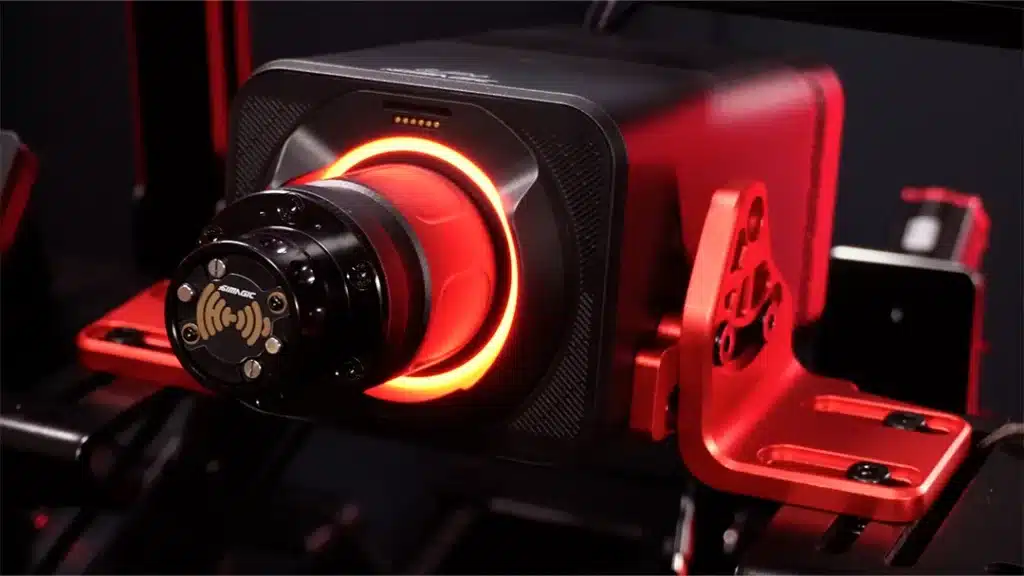
Our Verdict
Pros
- Incredibly smooth force feedback.
- RGB ring looks good in photos and video.
- Slimline design allows for better monitor positioning.
- Easy to mount with pre-drilled holes.
- Lower price than previous models.
Cons
- Plastic across the front and rear.
- Fake venting does nothing for the design.
- Longer than competitors.
- RGB light is hard to see behind steering wheel.
The SIMAGIC Alpha wheelbases have been fan favourites for many years, bridging the gap between performance and value. While it’s performed valiantly, it is now time for the next generation of SIMAGIC wheelbase to step up.
The new SIMAGIC Alpha Evo wheelbase is that next generation. Much like the original Alpha before it, the Evo comes in three versions, each offering a different price point and performance range. This new base offers a host of improvements and new features, while somehow lowering the cost of entry.
SIMAGIC has been very kind in sending out this Alpha EVO Pro wheelbase specifically for this review. So, it’s time to jump in and see exactly what’s on offer, and, importantly, how it performs.
Watch our SIMAGIC Evo Wheelbase Review
Unboxing and what’s included
Kicking things off, as you open the box, you’re greeted with the usual array of cables, stickers and a quick start guide. And then you get to the main attraction, the base itself.
First impressions are superb, thanks to the sleek, curved edges and the slightly textured, CNC machined aluminium outer case. While this may look like a big slab of metal, there are some really nice touches throughout.
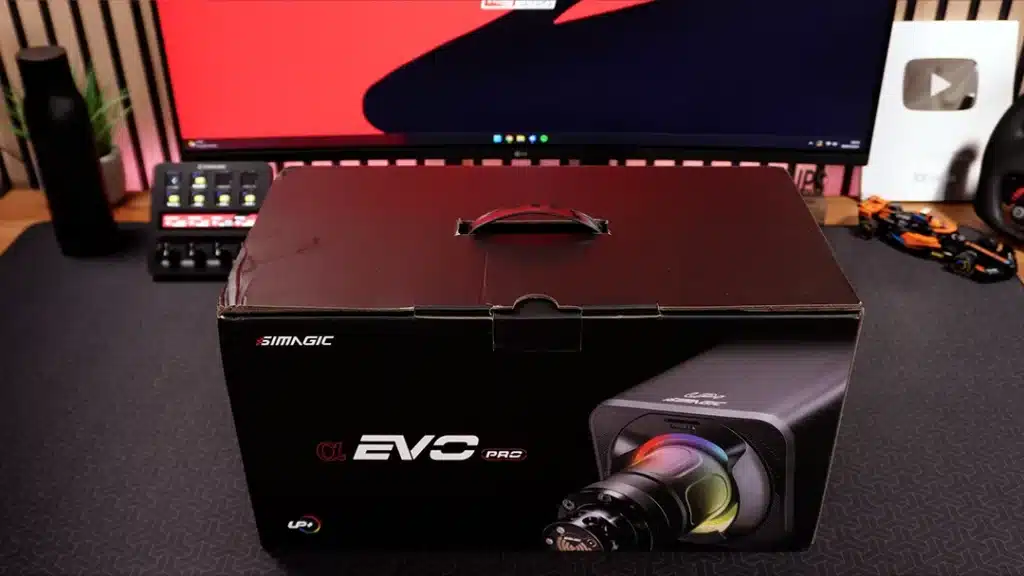
The front of the wheelbase features the illusion of vents. In the marketing images, these looked like real vents, but in reality they are a plastic design feature with zero venting.
There is branding throughout and additional fake vents at the rear. It also feels incredibly dinky, with a pretty slimline 130 x 110mm front profile. Compared to my Fanatec Clubsport DD+ here, the Fanatec wheel looks like a rather chunky boy.
Price of the SIMAGIC Alpha Evo Wheelbase
Before delving too far into our full design review, let’s talk prices. I mentioned that SIMAGIC has somehow managed to lower the cost of this wheelbase over the older Alpha, and that is true across all three variations.
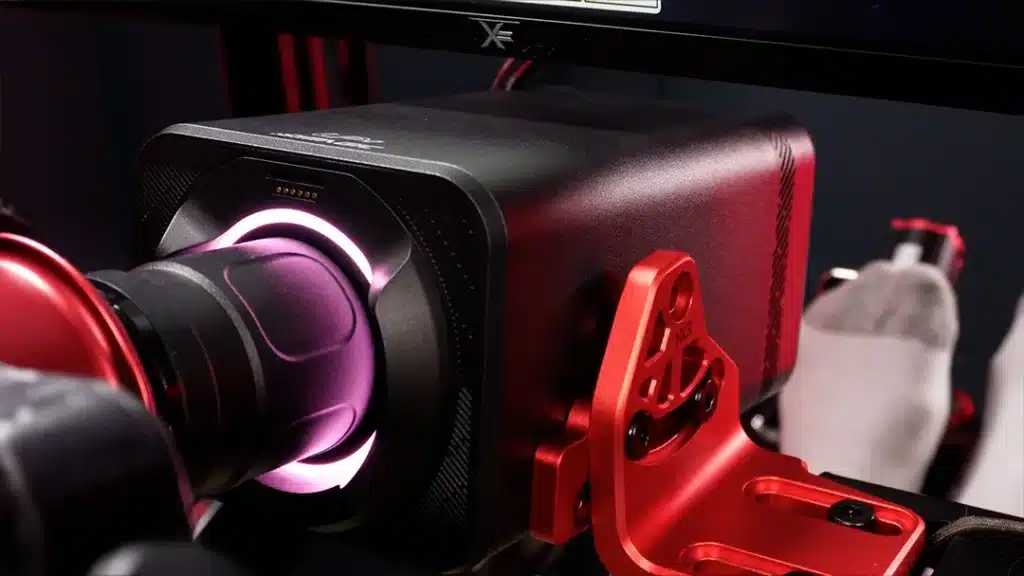
Rather than the Mini and Ultimate naming from the Alpha, SIMAGIC has opted to name these wheels the Evo Sport, Evo, and Evo Pro. Sounds familiar, right?
- The Sport model delivers 9Nm of peak torque, at a cost of $399.
- The Evo wheelbase increases the FFB strength upto 12Nm, and costs $549.
- The larger Evo Pro tops out at 18Nm of peak torque, and costs $699.
It is worth noting that these prices exclude tax, so depending where you’re located, this price will increase. I have included UK pricing as well from official reseller Race Anywhere, and the UK prices do include VAT.
| Product | Price |
|---|---|
| SIMAGIC Alpha Evo Sport Wheelbase | UK: £427 inc Tax US: $399 exc Tax |
| SIMAGIC Alpha Evo Wheelbase | UK: £577 inc Tax US: $549 exc Tax |
| SIMAGIC Alpha Evo Pro Wheelbase | UK: £731 inc Tax US: $699 exc Tax |
What is the competition?
You may have noticed that SIMAGIC has chosen to lower the peak torque values compared to the original Alpha wheel base. The Sport has 9Nm compared to 10NM of the Alpha Mini. The Evo has 12Nm compared to 15Nm of the Alpha. And the Evo Pro has 18Nm compared to 23Nm of the Alpha Ultimate.
SIMAGIC has also lowered the price for each model compared to the older Alpha bases. Below is a comparison between the older Alpha wheelbases, and the newer Alpha Evo wheels.
| Entry-level | Mid-Range | Premium | |
|---|---|---|---|
| Alpha Range | Alpha Mini = $539 | Alpha = $769 | Alpha Ultimate = $999 |
| Alpha Evo Range | Evo Sport = $399 | Evo = $549 | Evo Pro = $699 |
This is quite a tactical change in my opinion, with SIMAGIC really targeting other brands. The MOZA R9, one of the most popular MOZA wheels has 9Nm of peak torque, while their R12 and the Fanatec ClubSport DD both have 12Nm. SIMAGIC has mirrored these competitors with the Evo Sport and Evo.
With this pricing and force feedback output, SIMAGIC really has major player Fanatec beat in terms of value. The Alpha Evo Pro costs $699, and delivers more peak torque than the rather expensive Clubsport DD+, that now costs $1299 after the recent price increases. That is almost half the price of the comparable Fanatec wheel.
Does this make the SIMAGIC Evo a no brainer? Let’s find out with the rest of our review.
The design of the SIMAGIC Evo Wheelbase
Design is subjective, and I do like the aggressive styling of the ClubSport DD+ wheel. However, the smaller front profile and sleek curves of the Evo wheelbase are incredibly appealing.
Both the regular Evo and the Pro models are slightly longer than the MOZA R12 and Fanatec ClubSport DD. However, they are shallower in height than both competitors, which is the most important dimension. This lets you mount your TV or monitor that much lower, improving your immersion.

This more traditional, longer profile also reminds me of the more premium wheelbases from brands such as Simucube, as does the simple nature of the design. The aluminium housing adds a lot to this premium appearance.
Although it’s worth noting that the rear segment of the base is plastic and not metal. Not that you’ll see this part overly often, as it’ll likely be tucked behind a monitor or out of sight. Unfortunately, the entire front of the base is also plastic which you are more likely to see.
All three wheelbase variations bridge the gap between mid-range and premium, thanks to their curves and sleek design, while being slightly let down by the plastic finishes. However, the real party piece is the customisable RGB ring that wraps around the wheel shaft.
RGB Light ring
This isn’t the first time we’ve seen RGB lights on a wheelbase, with Asetek and Thrustmaster implementing RGB segments on their racing wheels. And if I’m being honest, it’s a feature that I can’t really get too excited about.
There is no doubt that the RGB ring looks striking in marketing images and videos. However, even after using the Asetek, Thrustmaster and now SIMAGIC wheels with RGBs, I’m yet to be sold on the application really adding anything to the experience.
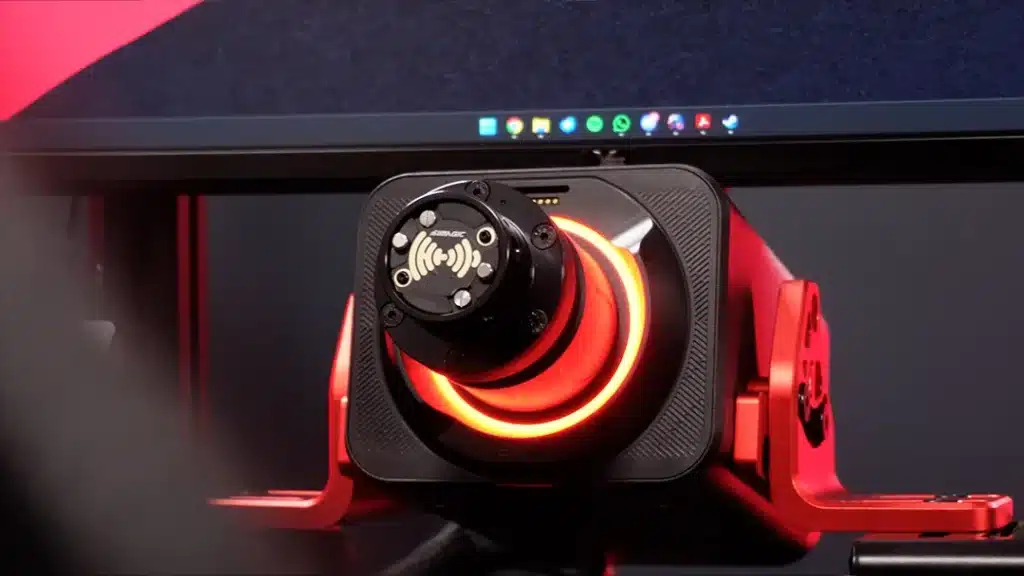
You can set the light to change based on telemetry data, which could be useful to some sim racers. But the positioning of the ring, right behind the wheel, means that depending on which steering wheel you use, you probably won’t see the RGB lights all that much.
I’ve had a few wheel rims connected to this wheelbase, including SIMAGIC’s own NeoX Hub, the Asetek Invicta wheel and the Mercedes-AMG F1 wheel. From my seating position, I can get a small glimpse of the RGB ring just above the top of the wheel.
The RGB’s are suitably bright, and in a dark room, you get a really nice glow coming from the wheel. However, for me, someone who relies on haptics or built in screens on my wheels, this light ring really doesn’t add anything.
Mounting
SIMAGIC has chosen to continue with the same mounting profile as the original base which is very handy if you’re upgrading from one to the other. You won’t need to adjust your sim rig to accommodate this new base.
The flexibility over mounting is great, with pre-drilled side and bottom mounting holes. This let you adapt the mounting position to whichever style of sim racing rig you have. And I had zero problems mounting this to my Next Level Racing cockpit. There are also front and side mounting accessories that open up the mounting options even more.
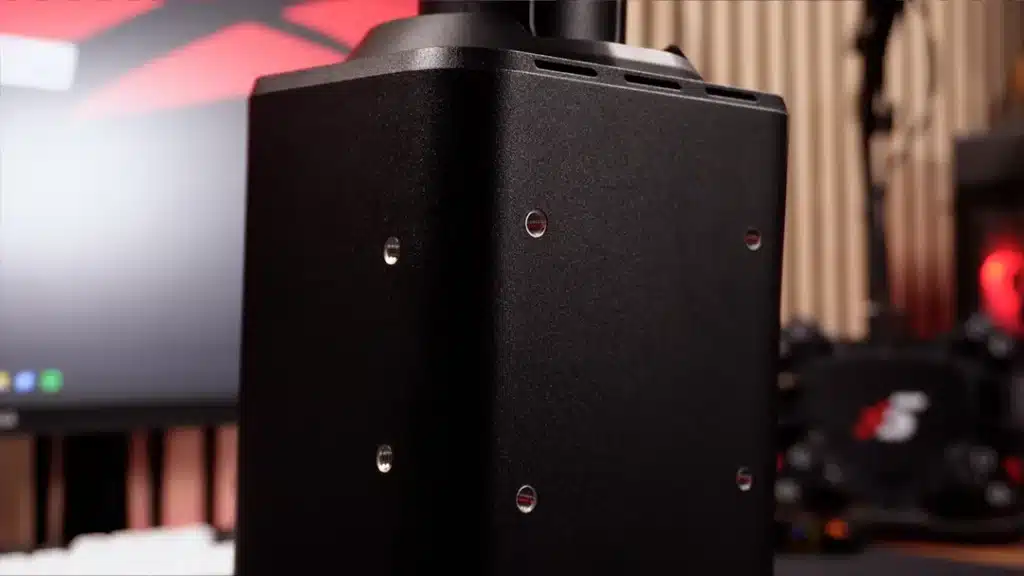
Connectivity
SIMAGIC has done an excellent job with the overall connectivity of this wheelbase. Most brands include a few ports on the rear for pedals and the odd shifter. The Evo wheelbase does have these ports, and then some.
Starting at the rear, you’ll find two full rows of data ports, with more connections than pretty much every other wheelbase on the market. There are a total of eight RJ ports, plus three USB ports. SIMAGIC has stated that they’ve also upgraded the connections to incorporate the improved CAN FD protocol. This allows for higher data transmission speeds and larger data payloads, removing the risk of any bottlenecks or performance stumbles.
Heading back to the front, SIMAGIC has add a series of magnets along the top of the wheel. These are designed specifically to incorporate the upcoming magnetic DDUs that SIMAGIC are working on. And they’ll let you easily snap a dash onto the base without any additional mounting requirements. This is a really nice touch when being used, however, when not in use, you do have the gold connections on show at all times. A little black cover would have been ideal for when a DDU isn’t in use.
Quick release
SIMAGIC has also improved the quick release over the Alpha bases. There are a new series of magnets incorporated into the quick release, ensuring even greater contact with your wheel. The SIMAGIC wheel-side QR still uses the tried and tested ball bearing connection method, despite introducing these magnets. These magnets primarily prevent wireless connection disruptions.
Both power and data is transmitted through these gold-plated connection ports from the quick release to the wheel base. This lets any SIMAGIC wheel transfer power without the need for cables and hard wiring.

The QR-A USB quick release, which is an additional extra, also includes a USB port directly into the adapter. This lets you connect any wheel that requires a direct connection directly to the QR. This works well with my Asetek Invicta wheel, and allows data and power to be transmitted via the wheel base, rather than having a dangling cable.
The front of the QR-A includes a 70mm PCD, which accommodates most third-party sim racing wheels.
What I don’t like about the design
Before looking at the software and performance, I do want to mention a few things I’m not keen on with the design. I’ve already mentioned the RGB light ring, so I won’t touch on that again. The inclusion of plastic at the rear of the wheel, and the plastic fake venting at the front removes a little of the premium look.
There is also a lot of branding across this wheel. On the front, we have a subtle Evo logo, which is nicely embossed. Then there’s a much larger “a” logo on the top of the rear, signifying the Alpha product lineup. And we also have the SIMAGIC logo and Up+ branding on the front of the wheel, signifying the overall Up+ modular ecosystem that includes the DDUs and steering wheels. Plus a sneaky SIMAGIC logo on the rear.

There are five individual brand logos or elements, and really, they aren’t needed. A simple SIMAGIC logo across the front or top would have done the job. Including the Up+ and Alpha branding, in particular, just confuses the identity a little, in my opinion.
There is also an ugly yellow sticker that says do not remove. Thankfully, it is easily removable. But those small and fairly inconsequential niggles are really it. Overall, I love the look and design of this wheel.
Software
Unlike Fanatec, you cannot adjust your force feedback settings on the wheel directly. You have to use the SimPro Manager software. This is SIMAGIC’s hub for controlling every piece of hardware in its ecosystem.
Compared to many sim racing software, SimPro is up there with one of the cleanest and easiest to use. You get a good amount of customisation and adjustments without ever feeling too overwhelmed.
After connecting your wheel and updating the firmware, you’ll see the Alpha Evo base activate in the bottom row of icons. Clicking this brings up all of the adjustments available.
Here, you can change various settings such as your force feedback strength and wheel rotation. Moving along, you can access more advanced settings if you want to really fine tune your experience. Every option has a nice pop-up helper to explain what the setting changes.
But if you don’t fancy learning the ins and outs of each advanced setting, there are a good number of presets available. SIMAGIC has included presets for pretty much every game, which adjust every part of the wheel.
You can also save your own presets, giving them specific tags, which let you filter them and find your preset quicker in the future. For example, I have various presets for different cars in ACC. Each preset is slightly different, but easily locatable thanks to the filter system.
This is also where you adjust the RGB lighting. You can turn on or off various telemetry controlled effects, and customise each one. This is the level of granularity I had hoped for, as I didn’t want my wheel flashing at me uncontrollably.
Instead, I can disable the telemetry I don’t want to use, and keep elements such as the pit limiter and DRS lighting effects enabled. I do love that you can change the colour and behaviour of each telemetry lighting setting as well. You can chose the colour and whether the light blinks and at which speed it blinks at.
Or, if telemetry RGB isn’t your thing, you can choose any static colour, or disable the lighting all together.
Performance review
Now, this is the part that really matters with any sim racing hardware, especially a wheelbase. The performance is really where SIMAGIC has spent a lot of time improving things.
All three of these new wheelbases boast the same improved force feedback algorithm and internal motor. SIMAGIC have chosen an ultra low inertia servo motor, and this results in much sharper and smoother force feedback. With this motor, the force feedback is lightening fast, and really comparable to the fastest responding wheels around such as the Fanatec ClubSport DD.

What I really noticed during my first few laps on track was just how smooth the force feedback feels. This is due to SIMAGIC’s “zero cogging” technology. Many wheels from other brands, including Fanatec, MOZA and Thrustmaster, occasionally suffer from stuttering.
You’ll see when I’m rotating my Fanatec wheel shaft here, that the rotation isn’t entirely smooth. The wheel sticks in certain places, giving the impression of gears or stuttering. Doing the same with the SIMAGIC Alpha Evo, I noticed some small amounts of juddering but far less than with my Fanatec wheel.
This is amplified on track, with the Evo delivering one of the smoothest force feedback experiences. It’s really up there with the impressive Asetek and Simucube wheel bases in terms of that smoothness. You really feel this in slower speed corners when making smooth sweeping inputs. It allows me to be incredibly precise with my steering.
Like many sim racing brands, SIMAGIC has introduced a new force feedback filtering algorithm. This ensures consistent torque with no peaks or fluctuations and lets you really feel the weight of your car and the details on the track surface.

The precision and sharpness of both inputs are thanks to a 21 bit encoder, an upgrade over the 18 bit encoder on the older Alpha wheelbases. The wheel also supports the 360Hz force feedback mode in iRacing.
Quite honestly, the force feedback from this wheel blew me away. I keep having to remind myself of the low price of this wheelbase. As the quality of the FFB details, response time and smooth nature of the feedback really challenges, and often beats what the premium brands such as Asetek, Simucube and Fanatec are offering.
Touching on the cooling. I’ve been racing with this wheelbase for often hours at a time, and the internal cooling does a great job of dissipating the heat. The wheelbase gets warm to the touch, but never hot. Even when maxed out for multiple hours.
Is the SIMAGIC Evo Wheelbase worth buying?
And that brings me to my final conclusion. Many sim racing brands have found their lane and stuck to it. Simucube and Asetek are your premium wheels, Fanatec and MOZA have battled for the mid-range supremacy while Thrustmaster and Logitech typically offer budget wheels.
SIMAGIC has always been the brand that bridges performance with value. This Alpha Evo goes further in this direction than ever. With the ultra competitive prices and insane performance, each of these wheel variations makes a strong case when compared against other brands.



I’ve always looked at Fanatec as the benchmark, or the Apple of sim racing, and I’ve always had a Fanatec wheel on one of my rigs at pretty much all times. You do pay a premium for their hardware, but generally, everything just works.
However, with the recent Fanatec price increases, and quite frankly, the excellent force feedback that these SIMAGIC wheelbases offer. I think my daily sim racing wheel has just become the Alpha Evo.
Despite the rather gimmicky RGB lights, the smooth and precise force feedback make this the wheel base to beat in 2025.
Frequently asked questions
The new Alpha Evo wheel base lineup is a direct replacement for the older SIMAGIC Alpha wheelbases. Despite the lower force feedback output, there have been huge improvements to the FFB detail and quality.
Technical Specifications
Review written by Felix König















